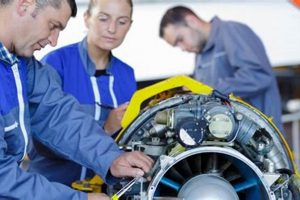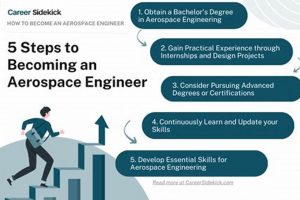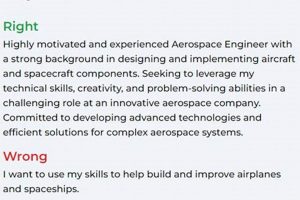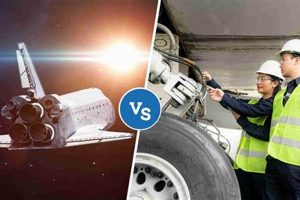Challenges within the field encompassing design, construction, and operation of aircraft and spacecraft are multifaceted. These can range from material science limitations at extreme temperatures to the complexities of ensuring safety and reliability in increasingly autonomous systems. For example, the development of hypersonic vehicles introduces problems related to thermal protection and aerodynamic control, while the proliferation of satellites in low Earth orbit presents challenges associated with space debris management and collision avoidance.
Addressing these problems is crucial for advancing air and space travel, enabling scientific discovery, and bolstering national security. Historically, innovation in this sector has driven technological advancements across numerous industries, from advanced materials to computer science. Success in overcoming present-day obstacles promises to unlock new capabilities in areas like space exploration, global communication, and air transportation efficiency.
The following discussion will delve into specific problem areas including sustainability considerations in propulsion systems, the integration of artificial intelligence in flight control, the growing need for enhanced cybersecurity measures in aerospace systems, and the ethical implications of autonomous weapons technologies.
Addressing Impediments in the Advancement of Flight and Spacecraft
Successfully navigating the multifaceted challenges inherent in the aerospace domain necessitates a strategic and informed approach. The following guidelines offer pathways to mitigate existing roadblocks and foster innovation.
Tip 1: Prioritize Interdisciplinary Collaboration: Complex systems require a holistic perspective. Encourage collaborative efforts between engineers specializing in diverse fields such as aerodynamics, propulsion, materials science, and software engineering. This facilitates a more comprehensive understanding of system-level interactions and potential failure points. For example, integrating structural engineers early in the design process can optimize weight reduction while maintaining structural integrity.
Tip 2: Invest in Advanced Simulation and Modeling: Computational tools are critical for predicting performance and identifying potential design flaws before physical prototyping. Employ high-fidelity simulations, including computational fluid dynamics (CFD) and finite element analysis (FEA), to model complex phenomena such as turbulence, heat transfer, and structural stress. This can significantly reduce development time and costs while improving system reliability.
Tip 3: Emphasize Cybersecurity Throughout the Development Lifecycle: As aerospace systems become increasingly interconnected and autonomous, cybersecurity vulnerabilities pose a significant threat. Implement robust security protocols at every stage of development, from design and coding to testing and deployment. Conduct regular penetration testing and vulnerability assessments to identify and mitigate potential weaknesses. For example, secure communication channels should be established for critical flight control systems.
Tip 4: Focus on Sustainable Design Principles: Environmental concerns are driving a need for more sustainable aerospace solutions. Prioritize the development of fuel-efficient aircraft, alternative propulsion systems (e.g., electric or hydrogen-powered), and materials with lower environmental impact. Explore opportunities for recycling and repurposing aerospace components to minimize waste. Life cycle assessments should be conducted to evaluate the environmental footprint of aerospace products.
Tip 5: Strengthen Research and Development in Advanced Materials: The performance of aerospace systems is often limited by the properties of available materials. Invest in research and development of new materials with enhanced strength-to-weight ratios, temperature resistance, and corrosion resistance. Examples include composite materials, ceramics, and high-temperature alloys. Breakthroughs in materials science can enable significant improvements in aircraft and spacecraft performance.
Tip 6: Foster a Culture of Continuous Learning and Adaptation: The aerospace field is constantly evolving, so professionals must stay abreast of the latest advancements and emerging technologies. Encourage participation in continuing education programs, conferences, and industry workshops. Promote a culture of knowledge sharing and collaboration to ensure that the workforce remains highly skilled and adaptable.
Effective implementation of these strategies promotes safer, more efficient, and more sustainable solutions, ultimately advancing the state of air and space technology.
By proactively addressing these key issues, the aerospace engineering community can pave the way for future innovations and continue to push the boundaries of what is possible in flight and space exploration.
1. Material Degradation
Material degradation represents a significant subset of concerns within aerospace engineering, directly impacting the reliability, safety, and lifespan of aircraft and spacecraft. Understanding the mechanisms and consequences of such degradation is crucial for mitigating risks and ensuring operational effectiveness.
- Corrosion Effects on Structural Integrity
Corrosion, particularly in metallic components, compromises structural integrity through weakening and material loss. This process is accelerated by exposure to harsh environmental conditions, such as saltwater spray, humidity, and temperature extremes. Examples include corrosion in aircraft fuselages and wing structures, potentially leading to catastrophic failures if undetected and unaddressed. Timely detection and preventative measures are essential to maintain safety.
- Fatigue and Crack Propagation
Cyclic loading, inherent in aerospace operations, induces fatigue in materials. This leads to the nucleation and propagation of cracks, which can ultimately result in component failure. Critical components, such as engine turbine blades and landing gear, are particularly susceptible. Regular inspections, non-destructive testing, and the use of fatigue-resistant materials are crucial for managing this form of degradation.
- Radiation Damage in Spacecraft Components
Spacecraft operating in the harsh environment of space are exposed to significant levels of ionizing radiation. This radiation can cause degradation of materials, particularly polymers and semiconductors used in electronic components. The result can be diminished performance, malfunctions, and even complete failure of critical systems. Radiation hardening techniques and strategic material selection are necessary to mitigate these effects.
- Thermal Stress and Material Creep
Aerospace components are often subjected to extreme temperature gradients, leading to thermal stress. Prolonged exposure to high temperatures can also induce creep, a time-dependent deformation of materials under stress. This is particularly relevant for engine components and hypersonic vehicles, where materials must maintain their structural integrity at elevated temperatures. Advanced materials with high creep resistance are essential in these applications.
- Impact from Micrometeoroids and Orbital Debris
Spacecraft are constantly at risk from impacts by micrometeoroids and orbital debris. These impacts can cause surface erosion, structural damage, and even penetration of spacecraft walls. Shielding, impact-resistant materials, and debris tracking systems are crucial for protecting spacecraft from these hazards.
In conclusion, material degradation presents a persistent engineering challenge necessitating thorough understanding, proactive monitoring, and advanced mitigation strategies. Failures to address it effectively can result in increased maintenance costs, compromised performance, and, most critically, safety risks that cannot be tolerated in this industry.
2. System Integration
Within the realm of aerospace engineering, system integration presents a constellation of difficulties, often representing critical barriers to project success. The inherent complexity of aerospace systems necessitates seamless interaction between disparate components, where failure in integration can lead to performance degradation, increased costs, and compromised safety.
- Software and Hardware Compatibility
Ensuring harmonious function between software and hardware is paramount. Mismatches in communication protocols, data formats, or processing speeds can result in system-wide malfunctions. The integration of newly developed sensor technologies with existing flight control software, for instance, demands meticulous validation to avoid data interpretation errors or control system instability. Incompatible systems can directly affect navigation accuracy and flight safety.
- Interoperability of Avionics Systems
Avionics encompass a range of critical systems, including communication, navigation, surveillance, and flight control. Their interoperability is vital for effective operation. Discrepancies in communication protocols or data sharing architectures can hamper information exchange, potentially leading to hazardous situations. The integration of unmanned aerial vehicle (UAV) avionics with air traffic control systems, to facilitate safe airspace integration, represents a significant integration challenge.
- Power Management and Distribution
Efficient and reliable power management is essential for sustaining all onboard systems. Integrating diverse power sources, such as solar arrays, fuel cells, and batteries, requires sophisticated control algorithms and distribution networks. Inadequate power management can lead to system failures, particularly in long-duration space missions where energy demands fluctuate considerably. The integration of high-power laser systems on airborne platforms, for example, demands careful consideration of power availability and distribution.
- Human-Machine Interface Design
The effectiveness of aerospace systems is significantly influenced by the design of the human-machine interface (HMI). A poorly designed HMI can lead to operator errors, reduced situational awareness, and decreased efficiency. Integrating complex sensor data into a user-friendly display requires careful consideration of cognitive workload and information presentation. The design of intuitive HMIs is especially crucial in autonomous systems, where operators must oversee complex operations and intervene when necessary.
These facets highlight the centrality of system integration to mitigating the range of problems encountered in aerospace development and operation. The successful resolution of integration challenges is crucial for enhancing system performance, ensuring safety, and reducing the overall cost of aerospace projects. The persistent need for improved integration methodologies is a key driver of research and development in the field.
3. Cybersecurity Threats
The increasing reliance on digital systems within aerospace engineering introduces significant vulnerabilities to cybersecurity threats. These threats span a wide range of potential intrusions that can compromise the integrity, confidentiality, and availability of critical aerospace assets.
- Compromised Flight Control Systems
Flight control systems, responsible for maintaining aircraft stability and trajectory, are prime targets for cyberattacks. Unauthorized access could allow malicious actors to alter flight parameters, disable safety features, or even take complete control of the aircraft. Examples include scenarios where manipulated sensor data leads to incorrect autopilot responses or deliberate disruption of air traffic management systems, with potentially catastrophic implications for safety and security.
- Data Breaches of Sensitive Information
Aerospace companies handle vast amounts of sensitive data, including design schematics, research data, and operational plans. Data breaches can result in the theft of proprietary information, giving competitors an unfair advantage, compromising national security, or exposing vulnerabilities in aircraft and spacecraft designs. The consequences of such breaches can range from financial losses and reputational damage to the compromise of critical national infrastructure.
- Disruption of Satellite Communications
Satellites play a crucial role in communication, navigation, and surveillance. Cyberattacks targeting satellite systems can disrupt these services, impacting civilian and military operations. Examples include jamming satellite signals, intercepting sensitive communications, or even taking control of satellite payloads. The potential for widespread disruption underscores the need for robust cybersecurity measures to protect these vital assets.
- Vulnerabilities in Autonomous Systems
The increasing adoption of autonomous systems in aerospace, such as unmanned aerial vehicles (UAVs) and autonomous spacecraft, introduces new cybersecurity challenges. These systems rely on complex software and communication networks, which can be exploited by malicious actors. Compromised autonomous systems could be used for espionage, sabotage, or even weaponized attacks. Ensuring the cybersecurity of autonomous systems is critical for realizing their full potential while mitigating risks.
The ramifications of cybersecurity breaches extend beyond mere data compromise, potentially jeopardizing both national security and the safety of air travel. The relentless advancement of cyber threats necessitates perpetual vigilance and the continuous improvement of cybersecurity protocols within aerospace engineering to safeguard both current and future aerospace assets.
4. Sustainable Practices
The incorporation of sustainable practices is increasingly critical in aerospace engineering due to mounting environmental concerns and resource constraints. Addressing sustainability deficits is not merely an ethical imperative but also a necessity for long-term operational viability and regulatory compliance.
- Fuel Efficiency and Alternative Fuels
The aerospace industry is a significant contributor to greenhouse gas emissions. Enhancing fuel efficiency through aerodynamic improvements, advanced engine designs, and lightweight materials directly reduces carbon footprint. Simultaneously, the exploration and adoption of alternative fuels, such as biofuels, hydrogen, and synthetic fuels, offer pathways to significantly reduce reliance on fossil fuels. The developmental hurdles and infrastructure requirements for these alternatives remain substantial.
- Noise Reduction Strategies
Aircraft noise pollution poses a significant health and quality-of-life burden on communities surrounding airports. Sustainable practices in this context include the development of quieter aircraft engines, optimized flight paths, and noise-reducing airport infrastructure. The challenge lies in balancing noise reduction with operational efficiency and economic constraints, as modifications often entail performance trade-offs.
- Waste Management and Recycling
Aerospace manufacturing and maintenance processes generate substantial amounts of waste, including hazardous materials. Sustainable waste management practices involve minimizing waste generation, implementing effective recycling programs, and safely disposing of hazardous substances. The complexities arise from the specialized materials used in aerospace applications, which often require unique recycling processes and facilities.
- Lifecycle Assessment and Design for Disassembly
A lifecycle assessment (LCA) evaluates the environmental impact of a product or process throughout its entire lifespan, from raw material extraction to end-of-life disposal. Integrating LCA principles into aerospace design allows for the identification of opportunities to reduce environmental impact at each stage. Design for disassembly (DfD) facilitates the efficient recycling or repurposing of components at the end of an aircraft or spacecraft’s operational life. This proactive approach addresses the growing concern of resource depletion and promotes circular economy principles.
Integrating sustainable practices is not simply a matter of adopting isolated technologies or strategies. It demands a holistic approach encompassing design, manufacturing, operation, and end-of-life management. Successful implementation necessitates collaboration between engineers, policymakers, and the public to overcome the inherent challenges and realize the long-term benefits of a more sustainable aerospace industry.
5. Regulatory Compliance
Adherence to regulatory mandates is inextricably linked to problems within aerospace engineering, acting as both a cause and a consequence of numerous issues. The stringent standards imposed by agencies like the Federal Aviation Administration (FAA) and the European Union Aviation Safety Agency (EASA) are designed to ensure safety, security, and environmental protection. However, the complexity and evolving nature of these regulations often present significant engineering challenges. For instance, new directives concerning aircraft emissions or noise levels necessitate substantial modifications to engine designs and aerodynamic profiles. The cost and technological hurdles associated with such compliance efforts can significantly impact project timelines and budgets. Furthermore, failing to meet these requirements can result in hefty fines, operational restrictions, or even the grounding of aircraft, underscoring the critical importance of robust compliance strategies.
One practical example is the ongoing effort to comply with stricter regulations concerning cybersecurity in aircraft systems. The increasing reliance on interconnected digital networks in modern aircraft creates vulnerabilities that malicious actors could exploit. Regulatory bodies are mandating enhanced cybersecurity protocols, requiring aerospace engineers to develop new security architectures, implement rigorous testing procedures, and establish incident response plans. This, in turn, necessitates specialized expertise, advanced software tools, and significant investment in cybersecurity infrastructure. The development and certification of these security enhancements represent a complex engineering undertaking that demands careful coordination between various stakeholders, including aircraft manufacturers, software developers, and regulatory agencies.
In conclusion, regulatory compliance is not merely an external constraint but an integral aspect of aerospace engineering. Addressing the problems associated with compliance requires a proactive approach that integrates regulatory considerations into the design process from the outset. Engineers must stay abreast of evolving regulations, develop innovative solutions that meet or exceed regulatory standards, and collaborate effectively with regulatory agencies to ensure that new technologies and designs are safe, secure, and environmentally sound. Overcoming these challenges is essential for maintaining the safety and sustainability of the aerospace industry.
6. Cost Overruns
The occurrence of cost overruns is a pervasive issue within aerospace engineering projects, stemming from a complex interplay of technical challenges, programmatic inefficiencies, and unforeseen circumstances. Cost escalation is not merely a budgetary matter; it directly impacts project scope, schedule, and, in some instances, overall feasibility. The aerospace sector, characterized by high technological complexity and rigorous safety standards, is particularly vulnerable to financial overruns that arise during research, development, testing, and production phases. These overruns frequently originate from underestimation of system complexity, unanticipated technological hurdles, or fluctuating material costs. Such instances directly impact the allocation of resources and can delay critical advancements in the field.
One illustrative example is the development of the James Webb Space Telescope. While ultimately a success, the project experienced significant cost overruns, increasing its initial budget multiple times. Contributing factors included the unprecedented scale of the telescope, the development of novel technologies required for its operation, and difficulties encountered during integration and testing. Similarly, numerous military aerospace programs have encountered significant cost overruns attributed to overly optimistic initial estimates, changing requirements, and complexities in integrating advanced technologies. These instances highlight the crucial need for meticulous planning, realistic budgeting, and robust risk management strategies throughout the project lifecycle. Effective cost control requires a thorough understanding of the technical challenges, a clear definition of requirements, and proactive management of potential risks.
The implications of cost overruns extend beyond immediate financial impacts. They can force difficult decisions regarding project scope, potentially leading to reduced capabilities or delayed deployment. Furthermore, cost escalation can erode public trust in aerospace programs and undermine support for future investments in scientific research and technological development. Consequently, addressing the causes and consequences of cost overruns is paramount for ensuring the long-term sustainability and effectiveness of aerospace engineering endeavors. This demands a concerted effort to improve project management practices, promote realistic budgeting, and foster a culture of transparency and accountability throughout the aerospace sector.
Frequently Asked Questions Regarding Issues in Aerospace Engineering
This section addresses common inquiries surrounding the challenges and concerns inherent in the field of aerospace engineering. The information provided is intended to offer clear and concise insights into the complexities and potential ramifications of these issues.
Question 1: What are the primary causes of delays in aerospace project timelines?
Aerospace project delays often stem from a confluence of factors, including unforeseen technological challenges, intricate system integration requirements, evolving regulatory landscapes, and supply chain disruptions. These elements introduce complexities that can significantly impact project timelines.
Question 2: How does material selection affect the lifespan and performance of aerospace vehicles?
Material selection is paramount in determining the lifespan and performance of aerospace vehicles. The ability of materials to withstand extreme temperatures, high stress, and corrosive environments directly impacts the durability, safety, and operational efficiency of the vehicles. The selection process considers factors such as strength-to-weight ratio, thermal resistance, and resistance to fatigue and corrosion.
Question 3: What role does cybersecurity play in modern aerospace engineering?
Cybersecurity plays an increasingly critical role in modern aerospace engineering due to the reliance on interconnected digital systems. Safeguarding flight control systems, communication networks, and sensitive data from cyber threats is essential for ensuring the safety, security, and reliability of aerospace operations.
Question 4: In what ways is the aerospace industry addressing environmental sustainability?
The aerospace industry is actively pursuing environmental sustainability through various initiatives, including the development of more fuel-efficient aircraft, the exploration of alternative fuels, the implementation of noise reduction strategies, and the adoption of sustainable manufacturing practices. These efforts aim to mitigate the environmental impact of air travel and space exploration.
Question 5: How do regulatory changes impact the design and development of aircraft?
Regulatory changes can significantly impact the design and development of aircraft. Compliance with evolving safety standards, emissions regulations, and noise restrictions often necessitates substantial modifications to aircraft designs, potentially increasing development costs and timelines.
Question 6: What are the main drivers of cost overruns in aerospace projects?
Cost overruns in aerospace projects are typically driven by a combination of factors, including underestimated system complexity, unforeseen technological challenges, changing requirements, and inefficient project management practices. Accurate cost estimation and proactive risk management are crucial for mitigating cost overruns.
In summary, addressing the issues identified here requires a comprehensive and multidisciplinary approach, involving collaboration between engineers, policymakers, and industry stakeholders. Continuous innovation and a commitment to excellence are essential for navigating the complexities of the aerospace field and ensuring its continued success.
The next section will delve into emerging technologies and their potential to revolutionize aerospace engineering.
Conclusion
The preceding exploration has highlighted the multifaceted nature of issues in aerospace engineering, encompassing challenges in material science, system integration, cybersecurity, sustainability, regulatory compliance, and cost management. Effective navigation of these obstacles is paramount for the continued advancement of flight and space exploration.
Given the sector’s critical role in national security, economic development, and scientific progress, sustained investment in research, education, and innovative problem-solving is essential. A commitment to addressing these persistent problems will shape the future trajectory of aerospace engineering, ensuring its ongoing ability to meet the evolving needs of society.







